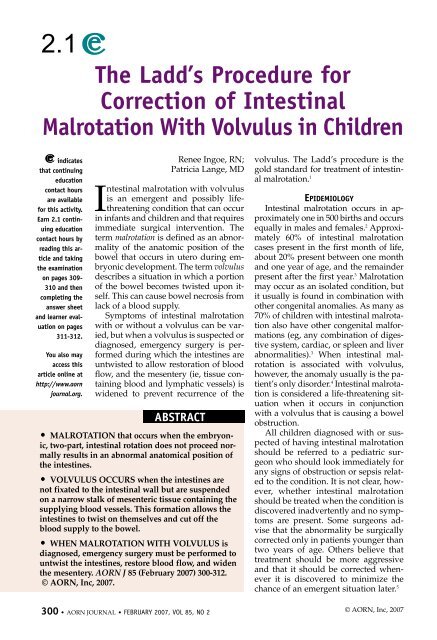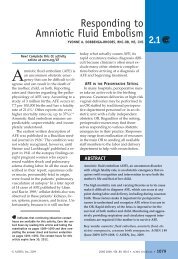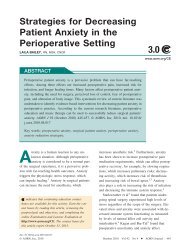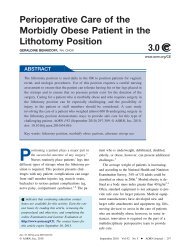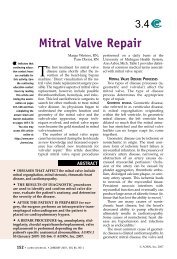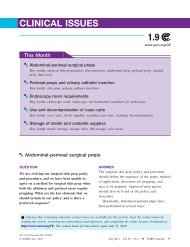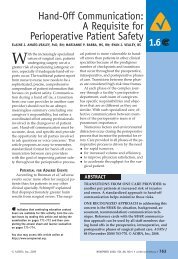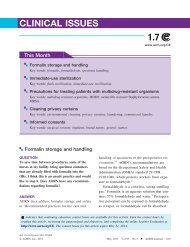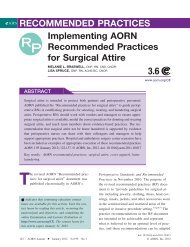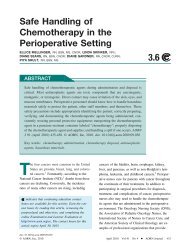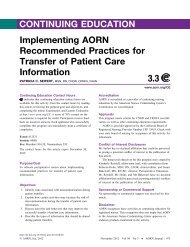The Ladd's Procedure for Correction of Intestinal Malrotation ... - AORN
The Ladd's Procedure for Correction of Intestinal Malrotation ... - AORN
The Ladd's Procedure for Correction of Intestinal Malrotation ... - AORN
You also want an ePaper? Increase the reach of your titles
YUMPU automatically turns print PDFs into web optimized ePapers that Google loves.
2.1<br />
<strong>The</strong> Ladd’s <strong>Procedure</strong> <strong>for</strong><br />
<strong>Correction</strong> <strong>of</strong> <strong>Intestinal</strong><br />
<strong>Malrotation</strong> With Volvulus in Children<br />
indicates<br />
that continuing<br />
education<br />
contact hours<br />
are available<br />
<strong>for</strong> this activity.<br />
Earn 2.1 continuing<br />
education<br />
contact hours by<br />
reading this article<br />
and taking<br />
the examination<br />
on pages 309-<br />
310 and then<br />
completing the<br />
answer sheet<br />
and learner evaluation<br />
on pages<br />
311-312.<br />
You also may<br />
access this<br />
article online at<br />
http://www.aorn<br />
journal.org.<br />
Renee Ingoe, RN;<br />
Patricia Lange, MD<br />
<strong>Intestinal</strong> malrotation with volvulus<br />
is an emergent and possibly lifethreatening<br />
condition that can occur<br />
in infants and children and that requires<br />
immediate surgical intervention. <strong>The</strong><br />
term malrotation is defined as an abnormality<br />
<strong>of</strong> the anatomic position <strong>of</strong> the<br />
bowel that occurs in utero during embryonic<br />
development. <strong>The</strong> term volvulus<br />
describes a situation in which a portion<br />
<strong>of</strong> the bowel becomes twisted upon itself.<br />
This can cause bowel necrosis from<br />
lack <strong>of</strong> a blood supply.<br />
Symptoms <strong>of</strong> intestinal malrotation<br />
with or without a volvulus can be varied,<br />
but when a volvulus is suspected or<br />
diagnosed, emergency surgery is per<strong>for</strong>med<br />
during which the intestines are<br />
untwisted to allow restoration <strong>of</strong> blood<br />
flow, and the mesentery (ie, tissue containing<br />
blood and lymphatic vessels) is<br />
widened to prevent recurrence <strong>of</strong> the<br />
ABSTRACT<br />
• MALROTATION that occurs when the embryonic,<br />
two-part, intestinal rotation does not proceed normally<br />
results in an abnormal anatomical position <strong>of</strong><br />
the intestines.<br />
• VOLVULUS OCCURS when the intestines are<br />
not fixated to the intestinal wall but are suspended<br />
on a narrow stalk <strong>of</strong> mesenteric tissue containing the<br />
supplying blood vessels. This <strong>for</strong>mation allows the<br />
intestines to twist on themselves and cut <strong>of</strong>f the<br />
blood supply to the bowel.<br />
• WHEN MALROTATION WITH VOLVULUS is<br />
diagnosed, emergency surgery must be per<strong>for</strong>med to<br />
untwist the intestines, restore blood flow, and widen<br />
the mesentery. <strong>AORN</strong> J 85 (February 2007) 300-312.<br />
© <strong>AORN</strong>, Inc, 2007.<br />
300 • <strong>AORN</strong> JOURNAL • FEBRUARY 2007, VOL 85, NO 2<br />
volvulus. <strong>The</strong> Ladd’s procedure is the<br />
gold standard <strong>for</strong> treatment <strong>of</strong> intestinal<br />
malrotation. 1<br />
EPIDEMIOLOGY<br />
<strong>Intestinal</strong> malrotation occurs in approximately<br />
one in 500 births and occurs<br />
equally in males and females. 2 Approximately<br />
60% <strong>of</strong> intestinal malrotation<br />
cases present in the first month <strong>of</strong> life,<br />
about 20% present between one month<br />
and one year <strong>of</strong> age, and the remainder<br />
present after the first year. 3 <strong>Malrotation</strong><br />
may occur as an isolated condition, but<br />
it usually is found in combination with<br />
other congenital anomalies. As many as<br />
70% <strong>of</strong> children with intestinal malrotation<br />
also have other congenital mal<strong>for</strong>mations<br />
(eg, any combination <strong>of</strong> digestive<br />
system, cardiac, or spleen and liver<br />
abnormalities). 3 When intestinal malrotation<br />
is associated with volvulus,<br />
however, the anomaly usually is the patient’s<br />
only disorder. 4 <strong>Intestinal</strong> malrotation<br />
is considered a life-threatening situation<br />
when it occurs in conjunction<br />
with a volvulus that is causing a bowel<br />
obstruction.<br />
All children diagnosed with or suspected<br />
<strong>of</strong> having intestinal malrotation<br />
should be referred to a pediatric surgeon<br />
who should look immediately <strong>for</strong><br />
any signs <strong>of</strong> obstruction or sepsis related<br />
to the condition. It is not clear, however,<br />
whether intestinal malrotation<br />
should be treated when the condition is<br />
discovered inadvertently and no symptoms<br />
are present. Some surgeons advise<br />
that the abnormality be surgically<br />
corrected only in patients younger than<br />
two years <strong>of</strong> age. Others believe that<br />
treatment should be more aggressive<br />
and that it should be corrected whenever<br />
it is discovered to minimize the<br />
chance <strong>of</strong> an emergent situation later. 5<br />
© <strong>AORN</strong>, Inc, 2007
Ingoe — Lange FEBRUARY 2007, VOL 85, NO 2<br />
ANATOMY AND PHYSIOLOGY<br />
During embryonic development, the<br />
colon and small bowel grow very rapidly.<br />
<strong>The</strong> bowel starts out as a straight tube<br />
from the end <strong>of</strong> the stomach to the rectum.<br />
6 As the intestines develop further,<br />
they move into the umbilical cord <strong>for</strong> a<br />
short time where they receive nutrients.<br />
Between the seventh and 10th week <strong>of</strong><br />
gestation, the bowel begins to gravitate<br />
back toward the abdominal cavity, during<br />
which time the intestines undergo a<br />
two-part rotation be<strong>for</strong>e assuming their<br />
normal position in the abdominal cavity.<br />
In the first phase <strong>of</strong> rotation, the<br />
duodenojejunal junction passes behind<br />
the superior mesenteric artery and becomes<br />
attached to the upper left retroperitoneum.<br />
In the second phase, the<br />
cecum passes from the left side <strong>of</strong> the abdomen,<br />
anterior to the superior mesenteric<br />
artery, and assumes its normal position<br />
right <strong>of</strong> the midline. At completion <strong>of</strong><br />
the rotation, the mesentery becomes attached<br />
to the retroperitoneum by a broad<br />
band from the upper left at the duodenojejunal<br />
junction (ie, the ligament <strong>of</strong> Trietz)<br />
to the lower right abdomen at the ileocecal<br />
junction, which prevents the intestines<br />
from twisting on themselves. 4 This<br />
process usually is complete by the 12th<br />
week <strong>of</strong> gestation.<br />
ABNORMAL BOWEL DEVELOPMENT<br />
<strong>Intestinal</strong> malrotation occurs when the<br />
two-part process does not proceed normally<br />
and the intestines do not make<br />
complete turns on re-entry into the abdominal<br />
cavity from the umbilicus. This<br />
abnormal rotation can have variable results.<br />
<strong>The</strong> cecum and the attached appendix<br />
may be positioned in the right upper<br />
quadrant, midline, or to the left <strong>of</strong> midline.<br />
With malrotation, the intestines are<br />
not secured to the abdominal cavity by<br />
the mesentery; instead, the intestines are<br />
suspended on a narrow stem <strong>of</strong> tissue (ie,<br />
mesenteric stalk) containing the supplying<br />
blood vessels (Figure 1).<br />
Lack <strong>of</strong> fixation and a narrow, mesenteric<br />
stalk allow the intestines to twist on<br />
themselves, a condition known as volvulus.<br />
A volvulus cuts <strong>of</strong>f the intestinal<br />
blood supply (ie, from branches <strong>of</strong> the superior<br />
mesenteric artery) causing vascular<br />
compromise that ultimately leads to<br />
catastrophic bowel infarction (ie, a massive<br />
loss <strong>of</strong> bowel as a result <strong>of</strong> the lack <strong>of</strong><br />
blood supply) that could result in death.<br />
When a volvulus involves the entire<br />
small bowel, it is referred<br />
to as a mid-gut volvulus<br />
(Figure 2). This can result<br />
in the loss <strong>of</strong> most <strong>of</strong><br />
the intestine and, in<br />
some cases, may result<br />
in death. 4<br />
Additionally, bands<br />
that normally fix the cecum<br />
to the sidewall may<br />
be abnormally situated<br />
within the abdominal<br />
cavity in such a position<br />
that they compress underlying<br />
bowel, causing<br />
partial or complete obstruction.<br />
<strong>The</strong>se abnormally<br />
positioned bands,<br />
referred to as Ladd’s<br />
bands, are named after<br />
William Ladd, MD, a pioneer<br />
in pediatric surgery.<br />
During a Ladd’s<br />
procedure, the mesentery<br />
is widened, the bands<br />
are ligated, and the appendix<br />
is removed to prevent future confusion<br />
because the cecum will be on the left<br />
side <strong>of</strong> the abdomen after the procedure.<br />
Obstructions caused by a volvulus or<br />
Ladd’s bands are life threatening and indicate<br />
the need <strong>for</strong> an emergency surgical<br />
procedure. 6<br />
SIGNS AND SYMPTOMS<br />
<strong>The</strong> presentation <strong>of</strong> intestinal malrotation<br />
can be extremely varied, from lifethreatening<br />
sepsis as a result <strong>of</strong> bowel<br />
<strong>The</strong> intestines<br />
gravitate from<br />
the umbilical cord<br />
back to the<br />
abdominal cavity<br />
and undergo a<br />
two-part rotation<br />
be<strong>for</strong>e assuming<br />
their normal<br />
position in the<br />
abdomen.<br />
<strong>AORN</strong> JOURNAL • 301
FEBRUARY 2007, VOL 85, NO 2 Ingoe — Lange<br />
Figure 2 • In<br />
a midgut<br />
volvulus, the<br />
colon is<br />
tightly coiled<br />
around the<br />
base <strong>of</strong> the<br />
mesentery <strong>of</strong><br />
the small<br />
intestine.<br />
302 • <strong>AORN</strong> JOURNAL<br />
necrosis to no symptoms at all. Bilious<br />
vomiting is the most common sign <strong>of</strong> intestinal<br />
malrotation with volvulus and<br />
should be considered a volvulus in infants<br />
until proven otherwise. Abdominal<br />
pain and lethargy also are common.<br />
Other symptoms may include sudden<br />
bouts <strong>of</strong> crying and drawing up <strong>of</strong><br />
the legs because <strong>of</strong> abdominal cramps;<br />
rapid heart rate; rapid breathing; and<br />
Figure 1 • Part <strong>of</strong> the small and large<br />
intestine are unattached so they can twist<br />
and cut <strong>of</strong>f blood supply, which will kill<br />
that part <strong>of</strong> the intestines.<br />
failure to pass flatus or stool. <strong>The</strong> child<br />
may become very dehydrated, which<br />
may manifest as decreased urination;<br />
dry mouth, lethargy; and possibly a<br />
depressed fontanel. When the intestines<br />
are compromised because <strong>of</strong> lack<br />
<strong>of</strong> blood flow, the infant’s vomit can<br />
become bloody. 5 Rectal bleeding is an<br />
ominous sign <strong>of</strong> bowel compromise<br />
and may indicate that the infant has a<br />
gangrenous bowel.<br />
A person can live with intestinal malrotation<br />
<strong>for</strong> life, however, and never experience<br />
any symptoms or present with<br />
signs <strong>of</strong> malrotation. In fact, malrotation<br />
in an adult usually is an incidental sign<br />
on a computed tomography (CT) scan<br />
diagnosed by the anatomic location <strong>of</strong> a<br />
right-sided small bowel, left-sided<br />
colon, and an abnormal relationship <strong>of</strong><br />
the superior mesenteric artery. 7 This<br />
malrotation would have occurred in<br />
utero but not have been found until<br />
much later in life. <strong>Intestinal</strong> malrotation<br />
in an adult also may be discovered during<br />
abdominal surgery that is being per<strong>for</strong>med<br />
<strong>for</strong> another reason (eg, cholecystectomy,<br />
trauma).<br />
DIAGNOSIS AND FINDINGS<br />
<strong>The</strong> most common and accurate way<br />
to diagnose intestinal malrotation with or<br />
without volvulus is an upper gastrointestinal<br />
(UGI) series. A barium enema<br />
(BE) also may be per<strong>for</strong>med but yields<br />
less in<strong>for</strong>mation. Both diagnostic procedures<br />
are quick and relatively safe, and<br />
they identify malrotation by demonstrating<br />
an abnormally positioned intestine.<br />
A UGI series is valuable in demonstrating<br />
the position <strong>of</strong> the ligament <strong>of</strong><br />
Treitz, a band <strong>of</strong> tissue that anchors the<br />
last part <strong>of</strong> the duodenum to the retroperitoneum.<br />
This portion <strong>of</strong> bowel<br />
should be positioned to the left <strong>of</strong> midline<br />
and approximately at the level <strong>of</strong> the<br />
gastroduodenal junction. Any abnormal<br />
positioning <strong>of</strong> this portion <strong>of</strong> intestine<br />
should be considered diagnostic or at
Ingoe — Lange FEBRUARY 2007, VOL 85, NO 2<br />
least suspicious <strong>for</strong> intestinal malrotation.<br />
A volvulus may be seen as a thin<br />
line <strong>of</strong> contrast in a portion <strong>of</strong> intestine<br />
that is abnormally positioned. Either<br />
finding should generate an immediate<br />
referral to a pediatric surgeon.<br />
Plain x-rays, ultrasounds, and CT<br />
scans are not as reliable as a UGI series<br />
because the UGI uses contrast media<br />
that lights up on the scan. <strong>The</strong> contrast<br />
either stops flowing or only moves<br />
through a thin opening. A contrast BE<br />
may be per<strong>for</strong>med <strong>for</strong> evaluation <strong>of</strong><br />
cecal position if the cause <strong>of</strong> the obstruction<br />
still cannot be determined<br />
after a UGI series is per<strong>for</strong>med. 4 A BE is<br />
more reliable than x-rays, ultrasounds,<br />
and CT scans but is not as reliable as a<br />
UGI series because the barium only<br />
flows up a certain distance, whereas the<br />
contrast in a UGI follows the intestines<br />
all the way down. <strong>The</strong> area above the<br />
obstruction would not be visualized<br />
during a BE.<br />
PREOPERATIVE PREPARATION<br />
When the OR is being prepared <strong>for</strong> a<br />
pediatric procedure, the circulating nurse<br />
turns up the room temperature to between<br />
75° F and 85º F (23.9º C and 46º C)<br />
depending on the surgeon’s preference.<br />
<strong>The</strong> circulating nurse places a pediatric,<br />
underbody, <strong>for</strong>ced-air, temperatureregulating<br />
blanket on the bed 8 and obtains<br />
an IV-solution warmer and irrigation<br />
fluid warmer. <strong>The</strong> circulating nurse<br />
ensures that the pediatric emergency<br />
anesthesia cart is in the room.<br />
PREOPERATIVE CARE OF THE PATIENT. After the<br />
infant has been admitted to the preoperative<br />
holding unit, the circulating nurse<br />
greets the patient and his or her parents<br />
and confirms the patient’s identity using<br />
at least two identifiers (eg, the identification<br />
band, medical record, parent’s confirmation).<br />
After reviewing the patient’s<br />
medical record, the nurse ensures that<br />
the patient’s laboratory, radiology, and<br />
gastrointestinal test results are on the<br />
chart and verifies that the surgical consent<br />
is accurate according to the patient’s<br />
records, OR schedule, and parents. <strong>The</strong><br />
nurse verifies the patient’s allergies and<br />
NPO status with the parents and medical<br />
record. <strong>The</strong> nurse then per<strong>for</strong>ms an<br />
assessment that includes the patient’s<br />
vital signs, nutritional status, skin turgor,<br />
and skin pallor. <strong>The</strong> nurse then develops<br />
a care plan specific <strong>for</strong> this patient undergoing<br />
the Ladd’s procedure<br />
(Table 1).<br />
CARING FOR THE PARENTS BE-<br />
FORE SURGERY. This surgery<br />
usually is per<strong>for</strong>med on an<br />
emergency basis, so the infant’s<br />
parents may be emotionally<br />
distraught. <strong>The</strong><br />
circulating nurse can take<br />
numerous actions to help<br />
alleviate some <strong>of</strong> the parents’<br />
fear. If possible, the<br />
circulating nurse should<br />
sit down with the parents<br />
and introduce himself or<br />
herself. <strong>The</strong> nurse should<br />
explain exactly what the<br />
role <strong>of</strong> the circulating<br />
nurse is in taking care <strong>of</strong><br />
their child and explain the<br />
role <strong>of</strong> each perioperative<br />
team member, including<br />
ancillary personnel.<br />
<strong>The</strong> nurse should speak<br />
in a s<strong>of</strong>t, calm, and reassuring<br />
tone and should not<br />
speak rapidly. He or she<br />
should give the parents<br />
time to ask questions and<br />
to contemplate what he or<br />
she is telling them. To instill trust, the<br />
nurse should make eye contact with<br />
each parent and use touch when appropriate.<br />
<strong>The</strong> nurse should ensure that all<br />
<strong>of</strong> the parents’ questions have been answered<br />
and that they understand the procedure<br />
completely. <strong>The</strong> nurse should reassure<br />
the parents that he or she will call<br />
the waiting room periodically to give<br />
<strong>The</strong> circulating<br />
nurse can take<br />
numerous actions<br />
to help alleviate<br />
the parents’ fear,<br />
such as speaking<br />
in a reassuring<br />
voice and<br />
explaining the<br />
role <strong>of</strong> the<br />
circulating nurse<br />
in taking care <strong>of</strong><br />
their child.<br />
<strong>AORN</strong> JOURNAL • 303
FEBRUARY 2007, VOL 85, NO 2 Ingoe — Lange<br />
TABLE 1<br />
Nursing Care Plan <strong>for</strong> Pediatric Patients Undergoing the Ladd’s <strong>Procedure</strong><br />
Diagnosis<br />
Risk <strong>for</strong><br />
compromised<br />
family coping<br />
related to the<br />
stress <strong>of</strong><br />
surgery<br />
Risk <strong>of</strong><br />
hypothermia<br />
related to<br />
perioperative<br />
environment,<br />
patient age,<br />
and exposed<br />
body surfaces<br />
Risk <strong>for</strong><br />
infection<br />
related to<br />
immature<br />
immune<br />
system<br />
and poor<br />
nutritional<br />
status<br />
304 • <strong>AORN</strong> JOURNAL<br />
Nursing interventions<br />
• Identifies communication barriers and<br />
knowledge level.<br />
• Assesses readiness to learn.<br />
• Elicits family members’ perception <strong>of</strong><br />
anesthesia and surgery.<br />
• Uses appropriate communication skills to<br />
ease fears and improve comprehension <strong>of</strong><br />
patient and family members, such as<br />
• sitting with family member when per<strong>for</strong>ming<br />
patient education,<br />
• making eye contact with each parent,<br />
• speaking slowly and clearly and observing<br />
<strong>for</strong> indications <strong>of</strong> confusion versus<br />
comprehension, and<br />
• allowing time <strong>for</strong> questions and answers.<br />
• Ensures parental presence during anesthesia<br />
induction, if desired and permitted by facility<br />
policy.<br />
• Evaluates family members’ response to<br />
instruction.<br />
• Monitors body temperature throughout the<br />
perioperative period.<br />
• Implements thermoregulation measures,<br />
including<br />
• heating the OR to between 75° F and<br />
85º F (23.9º C and 46º C);<br />
• placing a pediatric, underbody, <strong>for</strong>cedair,<br />
temperature-regulating blanket<br />
on the OR bed under the patient;<br />
• placing a stocking cap on the infant’s<br />
head;<br />
• using IV and irrigation solution warmers<br />
according to manufacturer instructions;<br />
and<br />
• wrapping the infant’s extremities with<br />
cotton cast padding to help minimize<br />
skin exposure as much as possible.<br />
• Evaluates response to thermoregulation<br />
measures.<br />
• Assesses skin integrity, sensory impairments,<br />
and gastrointestinal status.<br />
• Observes sterile field and perioperative<br />
team members to ensure that asepsis is<br />
maintained.<br />
• Validates that preoperative antibiotic was<br />
administered according to facility policy.<br />
• Allows sufficient time <strong>for</strong> surgical prep<br />
solution to dry be<strong>for</strong>e the patient is<br />
draped.<br />
Interim outcome<br />
criteria<br />
Patient’s family<br />
members<br />
• verbalize understanding<br />
<strong>of</strong><br />
the procedure,<br />
sequence <strong>of</strong><br />
events, and expectedoutcomes<br />
and<br />
• demonstrate<br />
the ability to<br />
cope throughout<br />
the perioperative<br />
period.<br />
Parents and<br />
patient demonstrate<br />
appropriate<br />
bonding.<br />
Patient’s core<br />
body temperature<br />
remains in expected<br />
range throughout<br />
the perioperative<br />
experience.<br />
Patient’s wound<br />
is dry, nonreddened,<br />
and<br />
non-tender.<br />
Patient does not<br />
demonstrate<br />
symptoms <strong>of</strong> infection<br />
(eg, wound<br />
induration, foul<br />
odor, purulent<br />
drainage, fever)<br />
Outcome<br />
statement<br />
Patient’s<br />
family<br />
members<br />
demonstrate<br />
knowledge<br />
<strong>of</strong> the<br />
physiological<br />
and<br />
psychological<br />
responses<br />
to the<br />
procedure.<br />
Patient is at<br />
or returning<br />
to normothermia<br />
at the<br />
conclusion <strong>of</strong><br />
the immediatepostoperative<br />
period.<br />
Patient is<br />
free <strong>of</strong><br />
signs and<br />
symptoms <strong>of</strong><br />
infection<br />
through the<br />
30 days<br />
after the<br />
perioperative<br />
procedure.
Ingoe — Lange FEBRUARY 2007, VOL 85, NO 2<br />
them updates on how the procedure is<br />
progressing.<br />
INTRAOPERATIVE NURSING CARE<br />
<strong>The</strong> circulating nurse and anesthesia<br />
care provider transport the patient to the<br />
OR. <strong>The</strong> circulating nurse ensures that all<br />
surgical team members are present and<br />
then initiates the surgical time out.<br />
INTRAOPERATIVE PATIENT WARMING. Infants<br />
and children—particularly those who<br />
are younger than one month old as is<br />
the case <strong>for</strong> many patients with intestinal<br />
malrotation—can lose body heat<br />
very rapidly and will lose even more<br />
body heat when the abdomen is<br />
opened. Infants<br />
• have a large body surface area in comparison<br />
to their size,<br />
• have only a thin layer <strong>of</strong> subcutaneous<br />
fat, and<br />
• are unable to shiver.<br />
All <strong>of</strong> these factors contribute to the<br />
possibility <strong>of</strong> rapid hypothermia <strong>for</strong> infants<br />
during surgery.<br />
Be<strong>for</strong>e transporting the patient from<br />
the preoperative area, the circulating<br />
nurse ensures that the patient is wearing<br />
a hospital stocking cap to prevent heat<br />
loss from the head. As soon as the patient<br />
is placed on the OR bed, the circulating<br />
nurse and anesthesia care provider institute<br />
active warming techniques. <strong>The</strong><br />
anesthesia care provider implements<br />
temperature monitoring that he or she<br />
will maintain throughout the surgical<br />
procedure; a nasopharyngeal temperature<br />
probe is a reliable method to approximate<br />
the infant’s core temperature. <strong>The</strong><br />
circulating nurse ensures that the pediatric,<br />
underbody, <strong>for</strong>ced-air, temperatureregulating<br />
blanket is turned on. 8<br />
<strong>The</strong> circulating nurse remains with<br />
the patient throughout induction <strong>of</strong><br />
anesthesia and <strong>of</strong>fers assistance to the<br />
anesthesia care provider as necessary.<br />
<strong>The</strong> anesthesia care provider inserts peripheral<br />
IV lines and uses a solution<br />
warmer according to the manufactur-<br />
er’s instructions to warm the IV solutions.<br />
When the peripheral IV lines have<br />
been inserted, the circulating nurse<br />
wraps the patient’s extremities with cotton<br />
cast padding, making sure it is not<br />
too tight. <strong>The</strong> scrub person uses irrigation<br />
fluids warmed by an irrigation<br />
warmer to approximately 98.6º F (37º C).<br />
<strong>The</strong> irrigation warmer keeps the fluids<br />
warm throughout the procedure and<br />
prevents the fluids from getting too<br />
hot, which can occur if irrigation<br />
fluids are taken<br />
directly out <strong>of</strong> a fluidwarming<br />
unit.<br />
Infants are<br />
ESSENTIALS OF POSITIONING.<br />
<strong>The</strong> circulating nurse, vulnerable to<br />
anesthesia care provider,<br />
and surgeon place the pa- hypothermia<br />
tient in the supine position.<br />
<strong>The</strong> circulating nurse during surgery<br />
places rolled-up sheets<br />
lengthwise alongside the because they have<br />
patient according to surgeon<br />
preference to keep a large body<br />
the patient from shifting to<br />
the side. <strong>The</strong> surgeon may surface area in<br />
place a rolled towel under<br />
the patient’s buttocks to comparison to<br />
gently lift the pelvis into<br />
a modified Trendelenburg their size, have<br />
position to displace abdominal<br />
contents upward. only a thin layer<br />
<strong>The</strong> circulating nurse or<br />
<strong>of</strong> subcutaneous<br />
surgeon may place plastic<br />
adhesive drapes around fat, and are<br />
the abdomen be<strong>for</strong>e the<br />
surgical skin prep is per- unable to shiver.<br />
<strong>for</strong>med to keep the patient<br />
warm and dry and to prevent<br />
pooling <strong>of</strong> fluids during<br />
the prep and the procedure.<br />
THE SURGICAL SKIN PREP. Patients <strong>of</strong> this<br />
age have immature immune responses.<br />
Furthermore, they may have poor nutritional<br />
status as a result <strong>of</strong> their condition,<br />
so they are less capable <strong>of</strong><br />
fighting infection. It is <strong>of</strong> great importance,<br />
there<strong>for</strong>e, to ensure that all team<br />
<strong>AORN</strong> JOURNAL • 305
FEBRUARY 2007, VOL 85, NO 2 Ingoe — Lange<br />
306 • <strong>AORN</strong> JOURNAL<br />
members strictly adhere to aseptic<br />
technique.<br />
<strong>The</strong> circulating nurse per<strong>for</strong>ms a<br />
surgical skin prep <strong>of</strong> the patient’s entire<br />
abdomen from nipple line to pubis<br />
with a solution <strong>of</strong> the surgeon’s preference.<br />
<strong>The</strong> nurse ensures that the prep<br />
solution has enough time to dry sufficiently<br />
and that no solution pools<br />
under the patient.<br />
THE PROCEDURE<br />
After the surgeon makes a midline laparotomy<br />
incision to ensure adequate visualization<br />
<strong>of</strong> the intestines and related<br />
structures, he or she takes the intestines<br />
out <strong>of</strong> the abdominal cavity and untwists<br />
them if a twist is present. <strong>The</strong> surgeon<br />
then removes any Ladd’s bands overlying<br />
the cecum or duodenum (Figure 3)<br />
with a goal <strong>of</strong> spreading out the mesentery,<br />
separating the small and large intestines<br />
as much as possible. Eventually, the<br />
surgeon positions the small bowel primarily<br />
to the right <strong>of</strong> the patient’s midline<br />
and positions the large intestine on<br />
the left. Although these bowel positions<br />
are the opposite <strong>of</strong> where they normally<br />
would lie if the complete turn had oc-<br />
Figure 3 • <strong>The</strong> surgeon excises Ladd’s bands so<br />
that the mesentery can be released, allowing the<br />
intestines to relax unrestrained.<br />
curred during fetal development, the<br />
bowel will remain in this backwards position<br />
<strong>for</strong> the rest <strong>of</strong> the patient’s life. <strong>The</strong><br />
cecum and appendix, there<strong>for</strong>e, are positioned<br />
on the left, and appendicitis could<br />
very easily be misdiagnosed later in life.<br />
To prevent this kind <strong>of</strong> misdiagnosis<br />
from occurring, the surgeon also will<br />
per<strong>for</strong>m an appendectomy. 4<br />
When a volvulus is present, the surgeon’s<br />
first step is to immediately untwist<br />
the intestine by rotating the bowel<br />
counterclockwise. After the surgeon has<br />
reduced the volvulus, the intestines<br />
usually are edematous and congested,<br />
and some areas may even appear necrotic.<br />
4 <strong>The</strong> surgeon observes the bowel<br />
closely <strong>for</strong> several minutes to verify viability<br />
<strong>of</strong> the bowel. If the bowel does not<br />
regain some normality be<strong>for</strong>e the end <strong>of</strong><br />
the procedure (ie, color change to indicate<br />
improved blood flow), the surgeon<br />
will resect the necrotic portions. If the<br />
surgeon has doubts as to the viability <strong>of</strong><br />
some areas, the patient will be brought<br />
back to surgery within 24 to 36 hours <strong>for</strong><br />
reevaluation.<br />
When the surgery is underway, the<br />
circulating nurse calls the waiting<br />
room to tell the parents that the procedure<br />
has started. <strong>The</strong> circulating nurse<br />
then calls periodically during the procedure<br />
to update the parents on the<br />
progress <strong>of</strong> surgery.<br />
POSTOPERATIVE NURSING CARE<br />
Where the patient is cared <strong>for</strong> and recovers<br />
after surgery depends on the<br />
surgical findings. Patients with uncomplicated<br />
malrotation with or without<br />
volvulus are managed on the pediatric<br />
surgical unit. Patients with severe volvulus<br />
or those needing extensive bowel resection<br />
<strong>of</strong>ten are acutely ill with shock or<br />
sepsis after the procedure, and require<br />
monitoring in the pediatric intensive care<br />
unit (PICU). <strong>The</strong> circulating nurse communicates<br />
closely with the anesthesia<br />
care provider and surgeon to plan <strong>for</strong> the
Ingoe — Lange FEBRUARY 2007, VOL 85, NO 2<br />
postoperative needs <strong>of</strong> the patient. <strong>The</strong><br />
circulating nurse calls the pediatric<br />
surgical unit nurse or PICU nurse during<br />
wound closure to communicate<br />
these needs. This gives the receiving<br />
nurse time to prepare the room <strong>for</strong> the<br />
patient. <strong>The</strong> circulating nurse’s report<br />
includes<br />
• the type and length <strong>of</strong> procedure that<br />
was per<strong>for</strong>med,<br />
• the amount and type <strong>of</strong> narcotics administered<br />
during the procedure,<br />
• the antibiotics received be<strong>for</strong>e and<br />
during the procedure,<br />
• the total amount <strong>of</strong> IV fluids administered<br />
intraoperatively,<br />
• the blood or blood products administered<br />
during surgery,<br />
• whether the patient will be extubated,<br />
and<br />
• the patient’s temperature during<br />
the procedure and a current end-<strong>of</strong>procedure<br />
temperature.<br />
More in<strong>for</strong>mation may be provided depending<br />
on specific unit policies and patient<br />
circumstances. <strong>The</strong> nurse also ensures<br />
that extra support staff members<br />
are available to assist with transporting<br />
the patient.<br />
ENSURING POSTOPERATIVE NORMOTHERMIA. A<br />
child’s body temperature can drop<br />
very quickly, particularly during extubation<br />
or transport to the postoperative<br />
unit. <strong>The</strong> nurse ensures that the<br />
patient is kept warm during this time.<br />
If the child will be transported in a<br />
crib, the circulating nurse lines the bed<br />
<strong>of</strong> the crib with warm blankets immediately<br />
be<strong>for</strong>e placing the patient in the<br />
crib and keeps the patient securely<br />
wrapped in a warm blanket, papoosestyle,<br />
as much as possible. <strong>The</strong> circulating<br />
nurse also places a rolled blanket<br />
behind the patient’s back to keep<br />
the patient on his or her side to prevent<br />
aspiration if vomiting occurs.<br />
AVOIDING POSTOPERATIVE HYPOXIA. <strong>The</strong> circulating<br />
nurse ensures that a full oxygen<br />
tank is on the transport vehicle (ie, crib,<br />
bed) and easily accessible. After moving<br />
the patient from the OR bed to the transport<br />
vehicle, the circulating nurse attaches<br />
one end <strong>of</strong> the oxygen tubing to<br />
the tank and holds or tapes the other<br />
end close to the patient’s mouth and<br />
nose so that the oxygen is blowing by<br />
the patient. This is much like using a<br />
nasal cannula <strong>for</strong> an older patient. This<br />
method <strong>of</strong> administering supplemental<br />
oxygen is continued<br />
until the patient’s oxy-<br />
gen saturation level consistently<br />
remains within<br />
normal limits.<br />
If the anesthesia care<br />
provider does not extubate<br />
the patient, the circulating<br />
nurse ensures<br />
the availability <strong>of</strong> a selfinflating,<br />
bag-valve-mask<br />
resuscitator <strong>for</strong> transport.<br />
<strong>The</strong> circulating nurse obtains<br />
a portable cardiac<br />
monitor to monitor the<br />
patient’s condition during<br />
transport to the postoperative<br />
recovery unit.<br />
PROVIDING POSTOPERATIVE<br />
NUTRITION. Infants who undergo<br />
extensive intestinal<br />
resections <strong>of</strong>ten are not<br />
able to tolerate enteral nutrition <strong>for</strong><br />
quite some time. If that is the situation,<br />
total parenteral nutrition (TPN) will be<br />
started and continued long term. Children<br />
on long-term TPN will be monitored<br />
<strong>for</strong> chronic liver damage, a risk <strong>of</strong><br />
long-term TPN. 2<br />
PROGNOSIS<br />
If intestinal malrotation with volvulus<br />
is recognized and treated quickly,<br />
the patient should recover well and<br />
not have any long-lasting effects, providing<br />
there is enough bowel left<br />
to sustain life. Children who have undergone<br />
this procedure most <strong>of</strong>ten<br />
progress through life with little or no<br />
Supplemental<br />
oxygen is<br />
administered<br />
until the<br />
patient’s oxygen<br />
saturation level<br />
consistently<br />
remains within<br />
normal limits.<br />
<strong>AORN</strong> JOURNAL • 307
FEBRUARY 2007, VOL 85, NO 2 Ingoe — Lange<br />
308 • <strong>AORN</strong> JOURNAL<br />
additional consequences. Very rarely,<br />
volvulus can recur after surgical correction.<br />
Small bowel transplantation<br />
sometimes is indicated in children<br />
who have lost a significant amount <strong>of</strong><br />
intestine.<br />
Individuals with intestinal malrotation<br />
but without associated volvulus<br />
may remain asymptomatic, and the<br />
condition may go undetected throughout<br />
life. Although some surgeons believe<br />
it should not be treated when discovered<br />
after infancy if the patient is<br />
asymptomatic, other surgeons believe<br />
it always should be treated surgically<br />
even if asymptomatic because <strong>of</strong> the<br />
lifetime risk <strong>of</strong> volvulus. 5 Some surgeons<br />
now are per<strong>for</strong>ming the Ladd’s<br />
procedure laparoscopically if there is<br />
no evidence <strong>of</strong> volvulus. This approach<br />
is especially useful if a diagnosis <strong>of</strong> intestinal<br />
malrotation is in question.<br />
Identifying structures appropriately<br />
and obtaining adequate separation <strong>of</strong><br />
the mesentery, however, can be technically<br />
difficult during a laparoscopic approach.<br />
In this case, the surgeon may<br />
need to abandon the laparoscopic approach<br />
midprocedure and convert to<br />
an open procedure. This is especially<br />
true <strong>for</strong> younger, smaller patients. ❖<br />
Renee Ingoe, RN, CNOR, is a perioperative<br />
staff nurse at Wake Med Health<br />
and Hospitals, Raleigh, NC.<br />
By supporting the <strong>AORN</strong> Foundation, you also<br />
support the advancement <strong>of</strong> perioperative nursing.<br />
<strong>The</strong>re are many ways to extend your personal<br />
legacy to the <strong>AORN</strong> Foundation, including<br />
• naming the <strong>AORN</strong> Foundation in your last will<br />
and testament;<br />
• allocating gift annuities;<br />
• committing charitable remainder/annuity trusts; or<br />
• naming the <strong>AORN</strong> Foundation as a beneficiary<br />
Patricia Lange, MD, is an assistant pr<strong>of</strong>essor<br />
<strong>of</strong> pediatric surgery at the University<br />
<strong>of</strong> North Carolina at Chapel Hill,<br />
Chapel Hill, NC.<br />
REFERENCES<br />
1. Parish A, Hatley R. <strong>Intestinal</strong> malrotation.<br />
Available at: http://www.emedicine.com/ped<br />
/topic1200.htm. Accessed December 7, 2006.<br />
2. Kamal, IM. Defusing the intra-abdominal<br />
ticking bomb: intestinal malrotation in children.<br />
CMAJ [online serial]. 2000;162. Available<br />
at: http://www.cmaj.ca/cgi/content<br />
/full/162/9/1315. Accessed December<br />
7, 2006.<br />
3. Cincinnati Children’s Hospital Medical<br />
Center. <strong>Intestinal</strong> malrotation. February<br />
2004. Available at: http://www.cincinnati<br />
childrens.org/health/info/abdomen/diag<br />
nose/intestinal-malrotation.htm. Accessed<br />
December 19, 2006.<br />
4. Ford EG, Senac MO Jr, Srikanth MS, Weitzman,<br />
JJ. <strong>Malrotation</strong> <strong>of</strong> the intestine in children.<br />
Annuals <strong>of</strong> Surgery. 1992;215:172-178.<br />
5. <strong>The</strong> American Pediatric Surgical Association.<br />
<strong>Malrotation</strong> and volvulus. Available<br />
at: http://www.eapsa.org/parents/rota<br />
tional.htm. Accessed December 7, 2006.<br />
6. KidsHealth. <strong>Intestinal</strong> malrotation. Available<br />
at: http://kidshealth.org/parent/med<br />
ical/digestive/malrotation.html. Accessed<br />
December 7, 2006.<br />
7. MedPix. Incidental malrotation and acute<br />
appendicitis. Available at: http://rad.usuhs<br />
.mil/medpix/medpix.html?mode=+search2.<br />
Accessed December 7, 2006.<br />
8. Bair Hugger® temperature management:<br />
model 555—pediatric underbody blanket.<br />
Arizant Healthcare. Available at: http://<br />
www.bairhugger.com/arizanthealthcare<br />
/faw_b_pediatric_555.shtml. Accessed January<br />
3, 2006.<br />
Foundation Offers Ways to Support Perioperative Nursing<br />
in a life insurance policy.<br />
You can double or triple your donation to the Foundation<br />
if your employer matches your donation. To<br />
find out if your employer will match your gift to the<br />
<strong>AORN</strong> Foundation, please check with your human resources<br />
department. For more in<strong>for</strong>mation on Foundation<br />
activities, call Nancy Harbin in the <strong>AORN</strong><br />
Foundation <strong>of</strong>fice at (800) 755-2676 x 366, or visit<br />
http://www.aorn.org/foundation.


